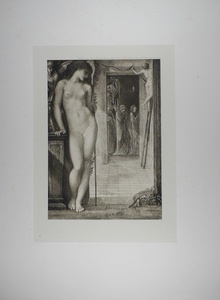| Method | Photogravure |
| Artist | after Sir Edward Coley Burne-Jones |
| Published | Published by the Berlin Photographic Company Berlin. _ London W.133 New Bond Street. _ New York 14 East 23rd Street. [c.1900] |
| Dimensions | Image 267 x 188 mm, Plate 338 x 246 mm, Sheet 667 x 507 mm |
| Notes |
Printed on India laid paper. Plate 6, taken from Burne-Jones' 1871 watercolour of the same title, from 'The Work of Edward Burne-Jones, Ninety-One Photogravures Directly Reproduced from the Original Paintings'. Only two-hundred copies of the 'The Work of Edward Burne-Jones...' were produced, each of which was signed by Philip Burne-Jones, the eldest son of Edward. A typical source of inspiration for artists associated with the Pre-Raphaelite movement was classical mythology, as is demonstrated by Burne-Jones' 'Venus Epithalamia'. Here, Burne-Jones illustrates the tragic love story of Venus. As is told in classical mythology, Venus was given to Vulcan in marriage, following an agreement between Vulcan and Jupiter that released Jupiter's consort and Vulcan's mother, Juno, from entrapment. Venus, however, was deeply in love with Mars, and it is said that whenever Venus was unfaithful, Vulcan would cause Mount Etna in Sicily to erupt. In Burne-Jones' 'Venus Epithalamia', Venus is portrayed hiding behind a doorway, within the first of three chambers illustrated in the painting. With a contrapposto stance, Venus gazes downwards with a melancholic expression. Behind the figure of Venus, partially hidden by shadows, is a small, masked Cupid. In the following chamber, another nude figure is depicted. Perching on a ladder, with his back to the viewer, the figure moves with energy whilst hanging a garland, which greatly juxtaposes against the static, and sombre, figure of Venus. In the final chamber, a procession of maidens pass the doorway, although they appear unaware of what is occurring in the other chambers. The procession of women appear to be a precursor to Burne-Jones' 'The Golden Staircase'. The title of the image makes reference to a particular aspect of the marriage ceremony. An 'epithalamia' is a wedding song, or poem, that was traditionally sung to the bride as she entered her marital chamber. The original watercolour was commissioned by Euphrosyne Cassavetti as a wedding present for her niece, Marie Spartali Stillman, upon her marriage to the American journalist and painter William J. Stillman. Spartali was a Pre-Raphaelite painter, and arguably the greatest female artist of the movement. Her career spanned over six decades, during which she produced over one hundred works. Maria Zambaco, both the mistress of Burne-Jones and the cousin of Marie Spartali Stillman, modelled for the figure of Venus. Rather suitably, the relationship between Zambaco and Burne-Jones mimicked that of Venus and Mars. Zambaco, too, entered into an unhappy marriage, later to fall in love with another man, that being Burne-Jones. Sir Edward Coley Burne-Jones, 1st Bt (1833-1898) was a painter and designer closely associated with the later phase of the Pre-Raphaelite movement. Burne-Jones met William Morris as an undergraduate of Exeter College, Oxford, whilst studying for a degree in theology. The pair went on to work very closely together on numerous decorative arts projects including stained glass windows, tapestries, and illustrations. Originally intending to become a church minister, Burne-Jones never finished his degree, choosing instead to pursue an artistic career under the influence of Dante Gabriel Rossetti. Rossetti heavily inspired his early work, but by the 1860's his idiosyncratic style was beginning to develop. His mature work, however different in total effect, is rich in conscious echoes of Botticelli, Mantegna and other Italian masters of the Quattrocento. Thusly, Burne Jones' later paintings of classical and medieval subjects are some of the most iconic of the Pre-Raphaelite movement. He was at the height of his popularity during the 1880's, though his reputation began to decline with the onset of the Impressionists. He was created a baronet in 1894, when he formally hyphenated his name. The Berlin Photographic Company, (1880 - 1920; fl) or the Berlin Photographische Gesellschaft, was a German print publishers who specialised in photogravures after Old Masters and contemporary painters. High quality photographs were taken of the original works. The negatives were then exposed onto a gelatin covered copper plate, etched with acid, and printed in a similar fashion to an engraving. The main series of the Berlin Photographic Company's publications is kept together at Blythe House, West Kensington. Condition: Foxing and discolouration to margins, water stains to upper right and lower left corners, not affecting image. |
| Framing | unmounted |
| Price | £400.00 |
| Stock ID | 41489 |

